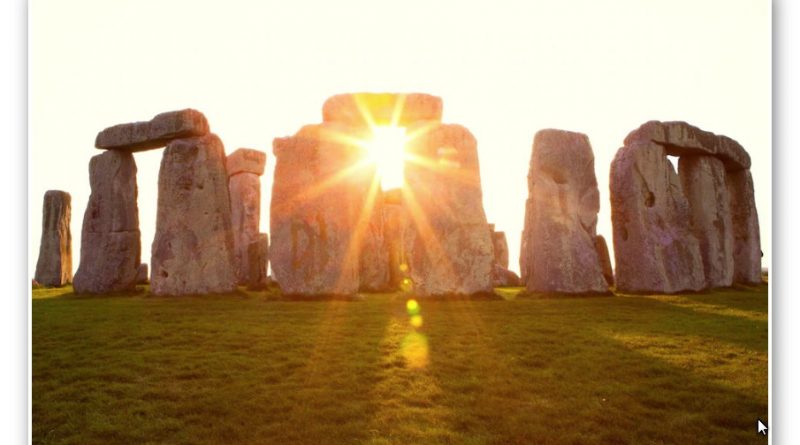Stone me – the druids are looking the wrong way on Solstice day
Stonehenge was initially built not to observe the midsummer solstice day sunrise as commonly believed, but more significantly the midwinter SUNSET some six months later and in the opposite direction!
The most popular view of Stonehenge is of a completely round monument with lintel stones completing the circle – but there is a massive problem with this idea, for not all the stones or the stone holes are present. Some people have suggested that the monument is incomplete, but those individuals do not understand its significance and the reason behind the construction.
A monument to the dead would not face the Summer Solstice Sunrise, it would either face the moon’s furthest setting in the night’s sky (the northwest and the lost Mesolithic Stonehenge pathway), or it would face Winter Solstice Sunset to mark the shortest day – when the light finally overcomes the darkness the symbolism of rebirth (life after death).
Another reason to ignore the reference to a solar temple is that the Sun is usually represented as life and a circular symbol, as we see in many ancient civilisations in the Middle East and South and Central America – where monuments to the dead are represented by the moon and particularly, a crescent moon.
Stonehenge was designed to be crescent-shaped, aligned to the Winter Solstice Sunset and hence the construction and alignment with a trilithon (two standing stones with a third suspended on top of the two uprights) in the south-west quadrant. Which only one survives and is still upright, which is not surprising as the druids in the Iron Age altered the monuments symbology by pulling the Heel stone to an awkward angle to meet the sunrise of the Summer Solstice, and no doubt pulled down the trilithon in the south-west quadrant.
The ‘crescent within the crescent’ (the larger horseshoe trilithon standing stones) that faces the Summer solstice sunrise; this is very symbolic as it represents rebirth or reincarnation; it’s a poignant message through the ages to us (the descendants of this civilisation), that their homeland may be dead, but the survivors still live on, to begin again. (Stone me – the druids are looking the wrong way on Solstice day)
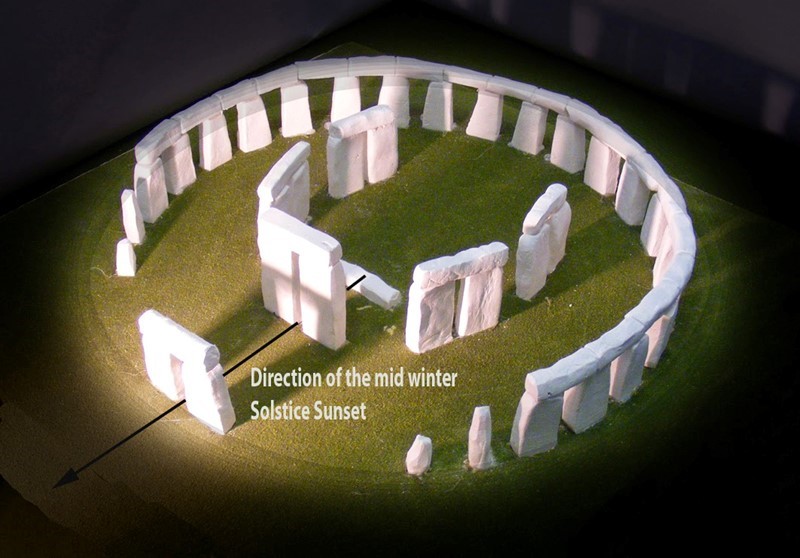
This can be proven in various ways. In archaeological terms, the fact that the stones are missing is a problem for archaeologists unless the monument was incomplete.
All the so-called missing stones of the monument are in the SW quadrant; this area is the furthest away from any roads – if you are going to cart away stones, would you not start at a point nearest a road, rather than the stones furthest away. The second problem with the Solar temple is that some of the existing stones that have not been moved or chipped away are not large enough to take a horizontal lintel stone – such as stone 11. Consequently, the only type of monument that the site could have been designed for is the crescent moon facing the Winters Solstice Sunset.
This is confirmed if you consider how the structure was designed. It would have been based on using strings to the centre and the moat forming a Hexagram (the reason this form was used is further discussed in the last book of the trilogy: ‘Dawn of the Lost Civilisation’).
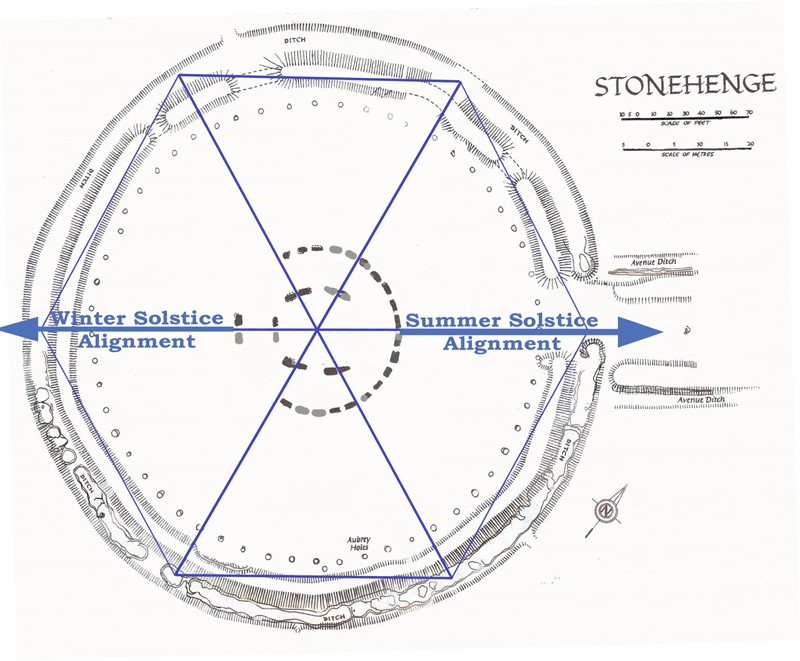
The Avenue
An indication of the changes introduced in Phase II of Stonehenge can be seen in the Avenue’s development to maintain the ceremonial link between Stonehenge and the river system. Our ancestors started by backfilling the ditch in the North-East sector of the site. Both Hawley and Atkinson observed that the secondary filling was not natural. This backfill extended to a depth of 1 m, at which pottery and bluestone fragments are first seen, clearly indicating that it preceded the arrival of the bluestones.
When the Avenue was first constructed, it could have had a dual purpose: to serve as the new mooring processional way for the dead and help maintain the groundwater levels because the moat had been reduced to a trickle as a consequence of the lower river levels.
We have seen in the archaeological section of our hypothesis that Hawley had found a liner in the moat. This liner would not have been required when the moat was first constructed, as the groundwater tables were sufficiently high to fill the moat, whether daily or periodically. But a liner would have been necessary once the tidal groundwater no longer reached the base of the pits. To keep the moat waters at a suitable depth, the pits would have needed to be topped up from time to time with either groundwater from the receding rivers around Stonehenge, precipitation like dew ponds or manual transference (or a combination of all three). (Stone me – the druids are looking the wrong way on Solstice day)
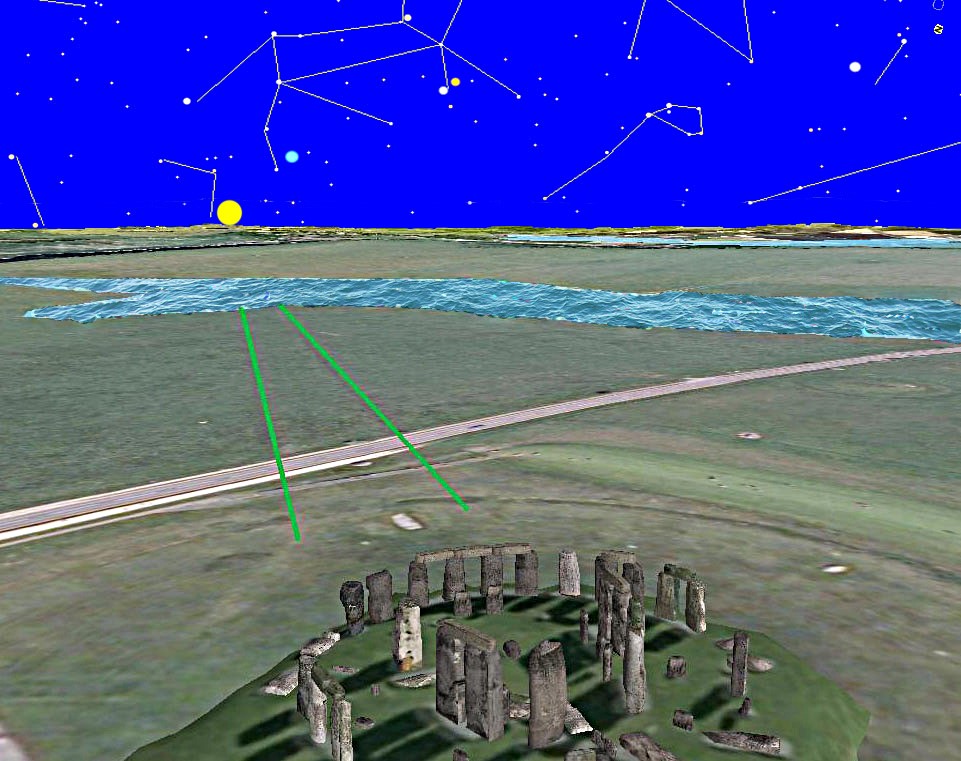
The Avenue is a processional causeway that had a deep trench built into both sides (over 1m deep in places). This trench is totally unnecessary unless there is another reason for its use, and that reason was either practical or symbolic.
The ditch allows water to travel along the Avenue all the way up to the existing moat, but there is no evidence that it is directly connected – but it doesn’t need to be as we have already illustrated the fact that chalk is a porous material that will allow water to flow through it over short distances.
Sarsen Stones
The Sarsen stones would have been brought to the Stonehenge site before the river disappeared from ‘Stonehenge Bottom” to become the River Avon of today. The reason why our ancestors used Sarsen stones is fascinating, as the original structure, which consisted of Welsh bluestones, lasted over 4,000 years as a centre for curing sickness. Clearly, they had a requirement for a colossal monument built of a different stone.
From an engineering point of view, the size and structure were significant, and because of the size of these stones, the most effective means of transportation to this site would again be by boat. Even though the deeply forested landscape would have started to thin, the sub-soils would still have been waterlogged and marshy after the groundwater had receded, making it impossible to drag heavy stones across large distances.
The construction of the Sarsen monument is of even greater interest because if they were building only for aesthetic pleasure, then you would imagine that simply laying one giant stone on top of another would be sufficient, as seen at other megalithic sites. But our ancestors wanted to do something special with these stones, so they carved mortise and tenon joints on their surfaces. The only engineering reason for this method of construction would be that they required this site to last for a considerable time in history and hence its importance to this civilisation.
The exact date of this process may never be fully known, for we have yet to excavate fully and carbon date the post holes in the Avenue similar to those in the car park at Stonehenge, which would give us an accurate date. But we still have a few clues to provide us with an approximate date, as we know that the river must yet have been present at the end of the Avenue for the unloading of these stones to take place. And it must have been after the groundwater left the North West shoreline, but before the groundwater reached the ‘elbow’.
The arranging of the Sarsen stones has left archaeologists without any clues about the dating of Stonehenge. The current theories are based on pottery and the dating of antler picks found in the ditch; all these items could have been left at a later date. For traditional archaeologists to be correct, then the pottery and the antler picks had to be left ‘in situ’, the archaeologist’s way of saying that something has not moved from the place where it was initially deposited – unfortunately, they were not!
As an example, the antler picks were found in the ditch. If the moat had been dug and then left untouched for 5,000 years, then you could have an entirely accurate date – but we have proved that the ditch was, in fact, a moat filled with groundwater. These picks would have floated away. We can say regarding the picks that the last time the moat was cleaned out was about 2500 BCE – and that’s it! And the same can be said about the pottery.
Let’s revisit the Avenue. It clearly follows a path to the river, but the river reached to the East of the site in Neolithic times, and therefore, in theory, the Avenue could have been built anywhere. So why did they build it in that particular direction? The North West entrance is oriented quite deliberately towards the midwinter moonset, perceived as the place of the dead and afterlife. After 4,000 years, is it possible that the monument changed its purpose? Four thousand years is a colossal amount of time – the same period before now, we were in the Bronze Age living in mud huts and dancing to druid music. In the landscape, we see that the monument’s use changed as round barrows started to appear and burial practices started to change.
If so, perhaps they decided to use the trusted waters of the past still but change it from curing the sick to celebrating life and rebirth through the Sun.
This may explain why the Avenue was oriented to the summer sunrise and, this being the case, give us our third clue to the date the site was built. We are familiar with the masses that welcome the midsummer sunrise over Stonehenge – people wait in expectation, then (if you’re lucky) the Sun creeps over the Heel Stone to greet another day; everyone’s happy and goes home drunk. When you look at the Heel Stone, it is on the extreme right-hand side of the Avenue, bent over at a silly angle. Our ancestors did not build it that way – the monument was very nearly completely rebuilt at the end of the last century, and stones were moved, and this process happened throughout Stonehenge’s history.
The most sensible alignment is straight down the middle of the Avenue. This is apparent alignment has only been partially investigated and, as a result, questions the ‘traditional’ dating of the site
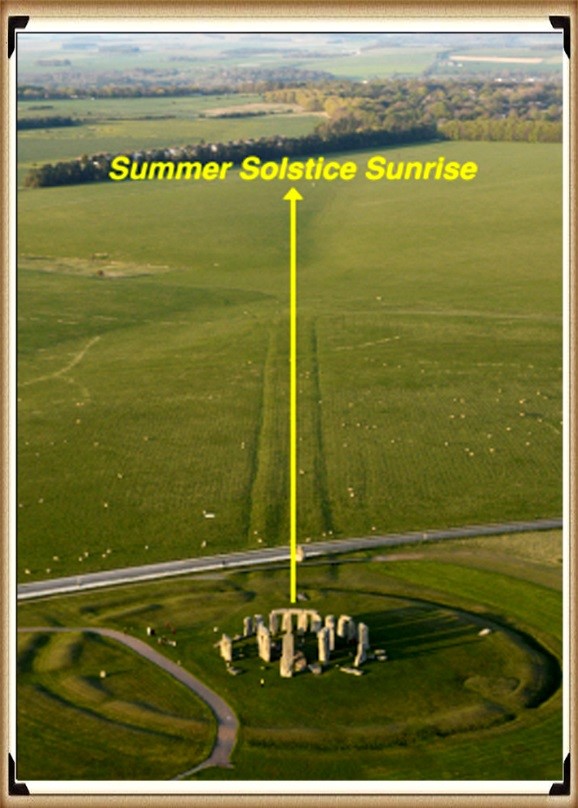
The Sun does not always rise and set in the same place in history as you may expect. The earth ‘wobbles’ on its axis in a process known as ‘procession’ – I will not go into detail here, but all you need to understand is that the Sun and moon rises and sets in a different location over a 43,000 year period.
This means that the summer and winter Solstice moves in relation to the horizon a fraction every year. This movement is TINY; it’s .0002 of a degree every year, but over a long time, say 10,000 years, it’s a full two degrees. It may not sound much, but when you consider that the moon is half a degree in diameter, then two degrees is the same as four moons (or suns) in a row on the horizon.
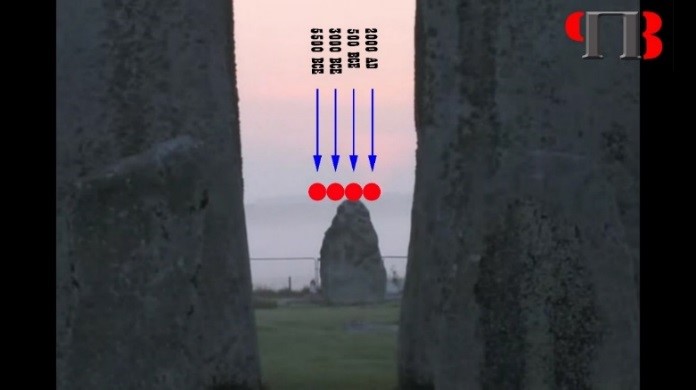
We can also ‘reverse engineer’ this figure to give us a date for the construction of the Avenue. The problem with this measurement is that the point of sunrise is somewhat subjective – as the horizon is obscured with trees at Stonehenge, so the tip of the first sunlight can never be fully seen. What current observers accept is the ‘Heel Stone’ position, which obscures the sunrise until a point that it appears to rise above the stones upper part (the peak point).
If we accept, this is the correct point for today’s Summer solstice sunrise and plot this point on Google Earth – we obtain a reading of 50.81 degrees. If we now take a reading down the centre of the Avenue with the same software, we get a reading of 49.57 degrees. This is a difference of 1.24 degrees since the Avenue was constructed. If each year the Sun moves 0.0002 degrees per annum, then we will have an approximate date (when the Sun is at the centre of the Avenue); this gives us a construction date of 6200 years ago or 4180 BCE.
Moreover, to support this dating – there is one antler bone that was found under a Sarsen stone, which does not support the current dating. Now this one can’t be explained away like the others, as a 12 ton stone was on top of it for thousands of years, guaranteeing that it could not have been placed there at a later date or floated there from another part of the site.
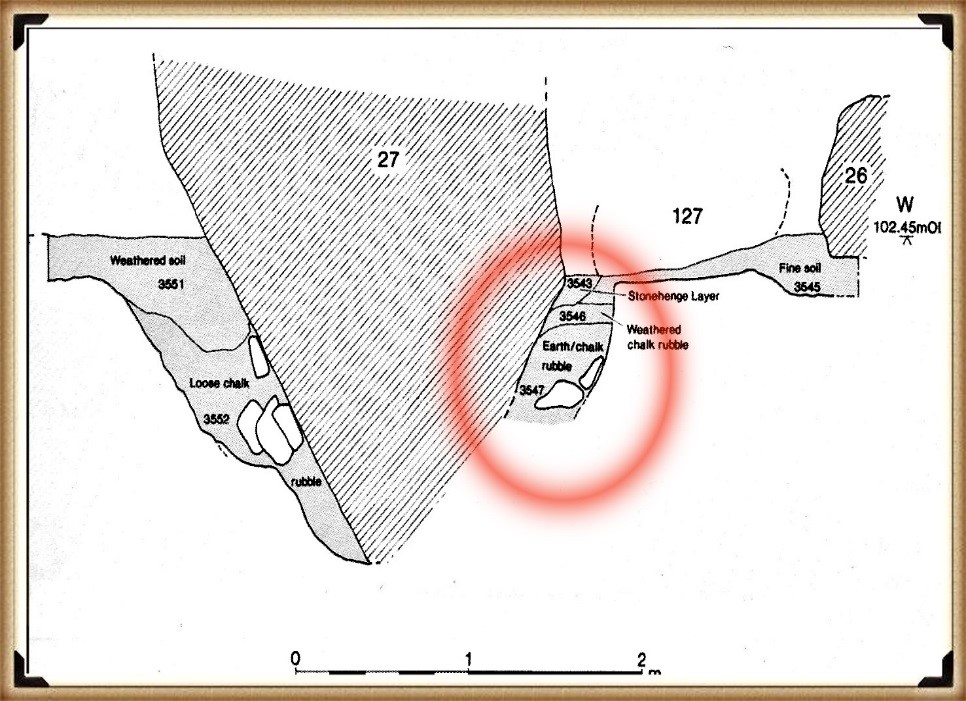
It was found in the ‘packing’ for Sarsen Stone 27 (OxA-4902). This gives us a carbon dating of 4342 – 4039 (IntCal20) or 4191 BCE +/- 152, which is remarkably similar to the Avenue dating method. Therefore, I am happy to conclude that Stonehenge phase two started around 4185 BCE.
The experts suggest that the antler bone was placed there by ‘accident’ and was found in the vicinity of the stone hole when constructed – sadly, this is very improbable as the bone would have been some 1700 years old (if current theory dates are correct) and would have rotted any if found on or near the surface.
More information about Stonehenge and can be found at our Website or Video Channel.
Further Reading
For information about British Prehistory, visit www.prehistoric-britain.co.uk for the most extensive archaeology blogs and investigations collection, including modern LiDAR reports. This site also includes extracts and articles from the Robert John Langdon Trilogy about Britain in the Prehistoric period, including titles such as The Stonehenge Enigma, Dawn of the Lost Civilisation and the ultimate proof of Post Glacial Flooding and the landscape we see today.
Robert John Langdon has also created a YouTube web channel with over 100 investigations and video documentaries to support his classic trilogy (Prehistoric Britain). He has also released a collection of strange coincidences that he calls ‘13 Things that Don’t Make Sense in History’ and his recent discovery of a lost Stone Avenue at Avebury in Wiltshire called ‘Silbury Avenue – the Lost Stone Avenue’.
Langdon has also produced a series of ‘shorts’, which are extracts from his main body of books:
For active discussions on the findings of the TRILOGY and recent LiDAR investigations that are published on our WEBSITE, you can join our and leave a message or join the debate on our Facebook Group.

